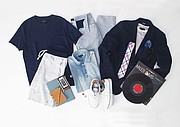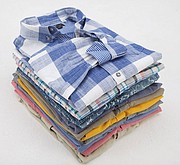INTERNATIONAL: Based in Ningbo, China, with U.S. headquarters in Costa Mesa, Calif., Dragon Crowd makes apparel for brands, specialty stores and department stores using its own textile mills, Asia-based factories and in-house design team.
DRAGON CROWD GARMENT
Connecting Asia to the U.S. Through Orange County
The office of Dragon Crowd Garment Inc. President J Spencer is neat as a pin. His big, shiny desk has nothing but a brass “J,” a computer and a cell phone on it.
“I’m a simple guy,” said Spencer, an Oklahoma native from a town of about 20,000. “I have a hard time focusing if I don’t keep things neat and tidy.”
The rest of the office is just as clean, and the 49-year-old’s calm demeanor seems to fit perfectly in the quiet setting. But what the office represents—an international knitwear manufacturer with more than $100 million in sales last year—is anything but spare.
Based in Ningbo, China, with U.S. headquarters in Costa Mesa, Calif., Dragon Crowd makes apparel for specialty stores and private labels for department stores such as the BP and Make + Model brands at Nordstrom.
“We are, at our core, a knitwear manufacturer; that is our greatest level of expertise,” Spencer said. Knits may be the foundation of Dragon Crowd’s business, but the company also produces woven tops, pants, jeans and jackets for men and women. But despite such assertions, the company’s plans look more like a strategy for market domination.
Dragon Crowd does not just make clothes for retailers to sell. It actually turns the old manufacturer-to-store-floor model on its head. Instead of waiting for customer orders, Dragon Crowd—using its own textile mills, Asia-based factories and in-house design team—brings finished products to retailers such as PacSun, Oakley, Hurley, Scotch & Soda, Bloomingdale’s and BCBG, Spencer said.
Founded in 1998 by Chief Executive Officer Edward Zhou in Ningbo (where he was born and raised), Dragon Crowd started as a production agency for retailers and apparel brands. But eventually, Zhou, now in his 40s and living in Orange County, became dissatisfied with the quality of textiles he was getting from manufacturers and decided to buy his own factory, said Dragon Crowd Marketing Director Jeff Marshall. The move allowed Zhou complete control of customer service and the supply chain that could deliver the quality garments he sought.
But with the pressures of fast-fashion retailers such as H&M, Zara and Forever 21, department and specialty stores began having a hard time delivering trends to their customers quickly enough.
That, according to Spencer, who joined Dragon Crowd in 2012, is when things started to change.
“Going into 2012 we started talking about what our customers were asking for: more innovation; style development; more design; more value input from the vendors in helping them to source better products, develop better products and put better products out to the customers,” Spencer said. “And that’s where we’re trying to respond in kind and become a much more vertically integrated organization so that we can provide all of those value-added services for the customer.”
In the past, retailers “would have done more of their own market research and their own product development. They would have looked less to the manufacturer for concepts and ideas and just told the manufacturer, ‘I want this jean. Go make this. I want this woven top. Go find the fabric and make it exactly like this,’” he explained. “Now we’re bringing them products, concepts, ideas and really putting together a vision of what’s happening in the market today and interpreting what we see coming down the pike for the future. In this office we like to say it’s innovation for inspiration. We innovate to inspire buyers and designers to be able to build the products that are right for their customers.”
Dragon Crowd’s model is fairly new, but it’s not the only one using it, said Frank Kaufman, Moss Adams LLP partner focusing on the retail and apparel sectors.
Kaufman calls the shift “Asian Fusion.”
“‘Asian Fusion’ is more applicable to the apparel industry than to food these days,” he said.
“We are seeing a trend of foreign-owned U.S.-based companies taking advantage of a vertical model to thrive. The U.S. side gets competitive pricing, timely delivery, financing terms and production flexibility. The Asia side gets a more secure and consistent order stream as well as enhanced stock value domestically. It is a compelling argument and why the strong will get stronger.”
Part of Dragon Crowd’s strategy for keeping up with fast-fashion trends is to use three of its own brands to test the market. In addition to supplying retailers with in-house brands, Dragon Crowd also produces lines that comprise about 10 percent of its business. Those lines are:
• 3rd & Army, which Spencer describes as “a brand built for a semi-contemporary young man who is looking for an Americana type of look.” The line sells $69 shirts, jackets for about $90 and tees printed with the brand logo for about $20 at The Buckle and several other specialty retailers across the U.S.
• Colorfast, a casual contemporary knitwear line sold at Urban Outfitters and Bloomingdale’s, includes tees, tanks and hoodies selling from about $30 to $45, Spencer said. “We develop 100 to 200 new fabrications of knits every single month. Colorfast is the brand we use to exploit that—to show the customer and say, ‘Look, this is what that looks like in this body style.’”
• Social Republic is a graphic tee line sold at Macy’s that Spencer said is meant to be a category killer. “It utilizes our abilities in knitwear, our expertise in being able to identify ways to reduce cost and build fabrications and still maintain the look to provide a product to big-box retailers that meets their quality needs, their design aesthetic and their pricing.” Social Republic T-shirts boasting giraffes dressed like singer Pharrell Williams in his signature oversized hat and rapper chains, an ostrich in a bowler hat, and a winged pig retail for about $24 each.
Propping up Dragon Crowd are 2,500 employees, four offices, three factories and three fabric mills. Plans for a fourth factory and a research-and-development department are underway for 2015, Spencer said.
Expanding with R&D
“There’s a lot of exciting things that are happening,” he said. “We’re focused intently on the innovation side of what we do and on building out our capacity.”
In January the new factory—and consolidation of other operations in China—will increase the number of employees to around 3,200, Spencer said. “On the top floor we’re going to put in 30 knitting machines so that we can continuously kick out fabric from that facility.”
The new factory and knitting facility will accommodate a research-and-development department that Spencer is especially excited about.
“If you look at some of the largest companies in the world—the Pfizers, the GlaxoSmithKlines—they spend 5, 10, 15 percent of their annual revenue on R&D,” he said. “While we’re never going to do that, there’s lessons to be learned from that. So we’re focusing intently on that department—taking it out of the specific business units within our organization and creating a unit that’s not gauged on driving topline revenue but that’s gauged on the innovation that they provide, which I think is a unique thing in this industry.”
Spencer expects the research-and-development effort to focus on adapting new technologies for synthetics that could be used in the burgeoning “athleisure” category.
“All of the athleisure wear—going from gym to street—it’s crushing the denim market now,” Spencer said. “It’s comfortable, but it’s all synthetic-based, so we’re focused intently on how can we take some of these things that are happening in the cotton-based market and develop those in the active market in synthetic fibers.”
For all of Spencer’s optimism, he said Dragon Crowd is mindful of its place in the sector—even with revenue projected to triple by 2019.
“We’re not a huge business; we’re a large business,” he said, “but we have some pretty-aggressive growth plans over the next five years.”

























